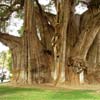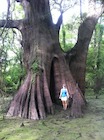Taxodium
Richard 1810
Common names
Baldcypress, swamp cypress.
Taxonomic notes
A genus generally assigned two species, though their chief difference is linguistic—one occurs in a country speaking English, the other, Spanish. They are:
Synonymy: Schubertia Mirbel 1812, Cuprespinnata J. Nelson 1866 (Farjon 2005).
The two species show only very minor differences in cuticle morphology, cone size and deciduous phenology. In accordance with the species concept as usually applied among conifers, they could be treated as subspecies or even varieties of a single species, and some authorities currently (2022) do so. However, since one species is the national tree of Mexico and the other has been a popular timber and ornamental tree for over 300 years, it would serve little purpose to attempt to combine the two taxa. Moreover, the taxa show both morphological and ecological differences that may warrant recognition at species rank. T. distichum includes two varieties, which are also sometimes segregated as distinct species but which are sympatric throughout almost the entire range and which are based on several differences that are environmentally determined (Watson 1985); thus they are not really even defensible as subspecies, let alone distinct species. See Farjon (2005) for a detailed discussion of this issue. Further light was cast on the subject by two molecular studies. One, a molecular study of nucleotide polymorphisms on individuals from the Mississippi River Valley and Gulf Coastal populations in Texas, Louisiana and Florida (Ikezaki et al. 2016), found consistent, although not large, genetic differences between the two varieties of T. distichum. A larger difference, however, distinguished the Florida from the Mississippi River Valley populations. The authors offer an late Miocene estimate for the age of differentiation into the two extant varieties. A second study examined allozymes of approximately 400 individuals from 21 locations across the range of the species, and found evidence for current or recent gene flow between vars. distichum and imbricarium, with clinal variation in the species (Lickey 2009).
A variety of morphological and genetic studies (the main ones are discussed under Cupressaceae) have established that this genus is a sister to Glyptostrobus and, slightly less closely, to Cryptomeria. This close similarity was early noted by Endlicher (1847) when he described Glyptostrobus and was later elaborated by studies of chloroplast and ribosomal DNA (Brunsfeld et al. 1994, Gadek et al. 2000, Kusumi et al. 2000) and seed cone development (Takaso and Tomlinson 1990, Farjon and Garcia 2005).
Description
"Trees deciduous or evergreen. Branchlets terete. Lateral roots commonly producing erect, irregularly conic to rounded "knees" in periodically flooded habitats. Leaves alternate, in 2 ranks or not. Adult leaves divergent to strongly appressed, linear or linear-lanceolate to deltate, generally flattened, free portion to ca. 17 mm; abaxial glands absent. Pollen cones with 10-20 sporophylls, each sporophyll with 2-10 pollen sacs. The pollen cones are usually borne at the base of alternate leaves, forming pendent axillary panicles; they occur less commonly singly or in racemes. Seed cones maturing and shattering in 1 season, nearly globose; scales falling early, 5-10, valvate, ± peltate, thin and woody. Seeds (1-)2 per scale, irregularly 3-angled, wingless; cotyledons 4-9. x = 11" (Watson 1993). The two species may be distinguished as follows (Farjon 2005):
| Leaf stomata most abundant on the abaxial side, in broader bands than on adaxial side; mature seed cones mostly 20-35 mm long. |
T. distichum |
| Leaf stomata about equally abundant on both sides; mature seed cones mostly 14-25 mm long. |
T. mucronatum |
Distribution and Ecology
Southern US, Mexico and Guatemala (Watson 1993), in riparian and wetland habitats.
Remarkable Specimens
The largest individuals are in Taxodium mucronatum. The oldest tree, 2,624 years, grows along the Black River in North Carolina, as detailed in the discussion of T. distichum var. distichum. Only four species of trees, all conifers, are known to attain greater ages (see How Old Is That Tree?).
Ethnobotany
See the species descriptions.
Observations
See the species descriptions.
Remarks
The name is combined from Taxus, the generic name of yew, and the Greek root -oides, "like" (Watson 1993), presumably in reference to the foliage.
Both species of Taxodium at least occasionally produce "knees," which are wooden growths that come off the root system and stick up into the air, sometimes to a height of as much as 2 m, resembling nothing so much as woody stalagmites. Knees are absent or inconspicuous in trees that do not experience at least seasonal submergence of the root system. For this reason it is widely thought that the knees are an adaptation to anoxic conditions, however, there is no evidence for such a function. Studies have not shown that the knees play any role in gas exchange. It has also been suggested that they perform a structural function, helping the tree to remain stable in soft, flooded soils. Here again, there is no real evidence (Briand 2000, Farjon 2005). I could hypothesize that the knees facilitate asexual reproduction. This is simply based on the observation that Taxodium, like other trees of the Taxodiaceous genera (Glyptostrobus, Metasequoia, Sequoia, etc.), can sprout from its roots, particularly when they are exposed to light; this ability may allow the tree to reproduce in conditions of flooded or anoxic soils that preclude successful reproduction from seed, and also might facilitate a more rapid recovery from fire or windthrow mortality.
Citations
Briand, C. H. 2000. Cypress knees: an enduring enigma. Arnoldia 60:19-25. Available http://arnoldia.arboretum.harvard.edu/pdf/articles/2000-60-4-cypress-knees-an-enduring-enigma.pdf, accessed 2017.03.05.
Farjon, A. and S.O. Garcia. 2005. The early development of ovuliferous cones in Cupressaceae s. lat -- A survey of the genera. Pages 27-46 (Chapter 4) in Farjon (2005).
Ikezaki,Y.; Y. Suyama; B. A. Middleton; Y. Tsumura; K. Teshima; H. Tachida; and J. Kusumi. 2016. Inferences of population structure and demographic history for Taxodium distichum, a coniferous tree in North America, based on amplicon sequencing analysis. American Journal of Botany 103(11):1937-1949, doi 10.3732/ajb.1600046.
Kusumi, J., Y. Tsumura, H. Yoshimaru and H. Tachida. 2000. Phylogenetic relationships in Taxodiaceae and Cupressaceae sensu stricto based on matK gene, ch/L gene, trnL-trn-F IGS region, and trnL intron sequences. American Journal of Botany 87(10): 1480-1488.
Richard, L. C. M. 1810. Note sur les plantes dites Conifères. Ann. Mus. Natl. Hist. Nat. (Paris) 16:296-299.
Takaso, T. and P.B. Tomlinson. 1990. Cone and ovule ontogeny in Taxodium and Glyptostrobus (Taxodiaceae - Coniferales). Botanical Journal of the Linnaean Society 109: 15-37.
Watson, F. D. 1985. The nomenclature of pondcypress and baldcypress. Taxon 34:506-509.
See also


